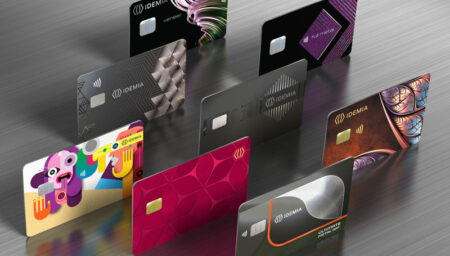Raising the payment experience bar

The future of payments will be decided by a myriad of micro-phenomenon, below we look at 6 trends that we think will be pivotal in defining how consumers will pay tomorrow.
Payment transactions have probably been a part of our world for as long as there has been human interaction. From barter to the first coins in Lydia 600 BC and the first bank notes in Sweden in 1661, to today’s mobile apps, payments have taken many forms over the centuries. This evolution continues at an unprecedented pace, as an example, the global card contactless transaction value will increase by 300% between 2020 and 20241. The future of payments will be decided by a myriad of micro-phenomenon, below we look at 6 trends that we think will be pivotal in defining how consumers will pay tomorrow.
With innovations such as AmazonGo or Uber, the traditional customer journey has been reversed:
In the traditional customer journey, it’s the opposite: you don’t CHECK IN (you just walk into a supermarket), but you do CHECK OUT (sometimes by standing in long lines, then have a cashier scanning your groceries and finally hand over a card or cash to pay). This shift from CHECK-OUT to CHECK-IN has a fundamental impact on the consumer experience making shopping easier and faster, as well as on merchants who are able propose a distinctive experience and therefore win the customers of tomorrow.
The payment experience is becoming seamless also during online shopping with the spread of “buy buttons” that enable the consumer to pay in just a click, making the whole process almost invisible and frictionless. A recent example of this is Visa, Mastercard, American Express and Discover establishing the EMV Secure Remote Commerce (SRC) framework and creating the “Click to Pay” button.
Until not so long ago, there were pretty much three ways to pay:
But today, any consumer has access to a plethora of different ways to pay. As we discussed above, our Uber ride is paid without any involvement from the consumer. We can also order (and pay) for our Starbucks’ latte macchiato by tapping in an app. In many countries, person-2-person apps allow to pay a friend the $10 we owe him/her. As 25% of Australians have had their wallet lost or stolen when going to the beach, 49% of Australian women have stuffed cash in their bras, and 39% of Australian men have used their swim-/underwear for the same purpose2. Today, a water resistant wristband, watch or a key fob with contactless payment functionality solve this hassle. We also shop by talking to smart home devices such as Alexa and soon our refrigerator will order and pay for milk before we run out of it. We can also make a purchase or transfer money without leaving our messaging app and do so as easily as sending a text message.
Not only have the number of payment instruments increased, so have the number of new payment interfaces. Coming back to cab drivers, if you don’t take an Uber, there is a fair chance your cab driver would only have accepted cash payments some years ago. Today, you can most likely pay for the ride through a mPOS device connected to the driver’s smartphone or via the smartphone itself acting as a payment terminal. In Seoul, complete walls in busy metro stations have been converted into one big screen replicating a super market shelf. The consumer can simply tap on the wall to select his/her item, pay by tapping a card to the screen to have the goods delivered to his/her doorstep. In some pubs, tapping your contactless card on a beer pump will unlock the pump for a pint of beer that you pour into your glass yourself.
And in all of this, what about the payment cards? As more and more of the traditional “physical touch-points” (bank branches, monthly account statements in paper format sent to your letterbox) are being reduced or have disappeared altogether, the payment card is arguably the last “physical” link between a bank and its customers. Consequently, we see banks leveraging the bank card by innovative designs to strengthen the loyalty and reinforce the brand even further. Very interestingly, we also witness how the most digital of the digital, the Neobanks and the Techs Giants, are not only launching cards, but in many instances even launching metal cards. These cards have proven an excellent tool in segmenting the customer base and conveying values such as slick, modern, exclusive, premium. It is also a way for many Neobanks to position themselves vis-à-vis incumbent banks. On top of that, cards are also going digital and banks are enabling their customers to digitize their cards into third party wallets or bank branded wallets for proximity, in-app and P2P payments.
In markets where card payments were established years ago (where you could say that cash payments were replaced by cards), we see physical card payments AND mobile payments flourish side by side, typically with cards for in-store payments and mobile apps for person-2-person transactions.
In Norway, one of the world’s most developed payment markets, the average consumer uses the payment app Vipps several times a day. But that doesn’t prevent the same consumer from paying with his/her payment card a staggering 475 times/year3. In China, where one could argue that it was WeChat and AliPay who replaced cash, consumers have embraced mobile payments in-store to a higher extent than anywhere else in the world: 84% of Chinese consumers use WeChat, 81% AliPay, to be compared to 9% of U.S. (where paying by card has been deeply engraved in the mindset for years) consumers using Apple Pay4.
Whether consumers pay in-store or online, identity is inextricable from the payment experience. Digital identity and biometrics, especially on mobile devices, enable security to be increasingly integrated into the existing consumer experience. Consider the role that identity has always played in the world of payments. It used to be that the signature on the back of a card matching against the signature on the receipt was enough to verify the transaction. You can now contact your bank for lost or stolen credit cards and be authenticated by scanning your identity document. You can also pay with your fingerprint or your face at point of sales or being authenticated silently just by shopping from your smartphone.
Tomorrow we will have a cashier-less retail experience where people can walk into a store, pick up the things they want to buy, and walk out without ever going through a checkout or presenting a payment card at all. This is more valid in the ecommerce space, where trust needs to be established in a highly fragmented ecosystem. And all of this is only possible when identity and payments converge. Payments has come a long way since the first coins were minted in Lydia more than 2,500 years ago, and the evolution continues. We can only speculate about the future, Thomas Likar from PayPal is surely on to something when saying “if there’s one word to describe the direction that the payments industry has headed over the past year, I think it’s this: convenience”5.
Sources
1 https://www.paymentscardsandmobile.com/contactless-payment-transactions-to-teach-6-trillion-2024/
2 Hands-free Payments Survey, Westpac, 2017
3 Norges bank paper, Retail payment services 2018
4 CNBC, Mobile payments have barely caught on in the US, 2019
5 PaymentEye, It’s all about convenience: the payments industry in 2019

Related Content